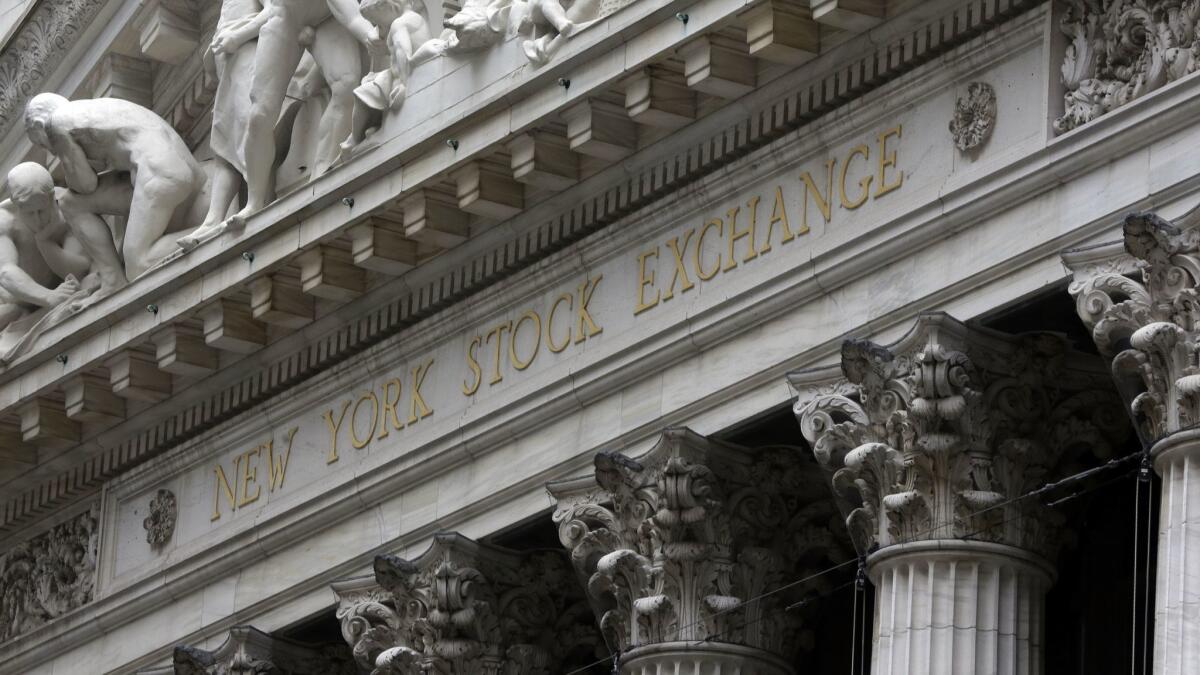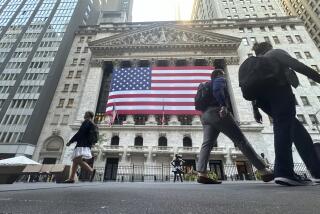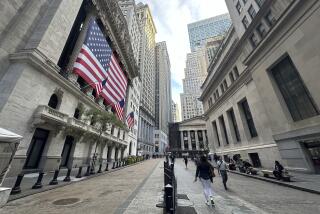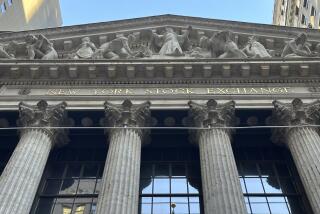Stocks hit new highs: Dow tops 27,000 and S&P 500 ends just shy of 3,000

A turbulent day on Wall Street ended in the record books Thursday as the Dow Jones industrial average climbed above 27,000 for the first time and the benchmark Standard & Poor’s 500 index closed at another all-time high.
Earlier on Thursday, the S&P 500 briefly moved above 3,000 for the second straight day before an early rally lost some of its momentum.
The market lost some ground after an auction of long-term U.S. government bonds failed to drum up strong demand. That pulled bond prices lower, sending yields sharply higher.
Banks and technology stocks led the broad gains, offsetting losses by real estate and communications services stocks.
The latest gains extended stocks’ winning streak to its third day. Stocks have been trending higher for much of the week as investors have grown more confident that, as soon as the end of this month, the Federal Reserve may cut interest rates for the first time in a decade.
“Sure, 27,000 is just a number and in the whole scope of things isn’t meaningful,” Ryan Detrick, senior market strategist for LPL Financial, said of the Dow’s milestone. “What it is, though, is a reminder for all investors that this bull market has ignored all the scary headlines for years and the dual benefit of fiscal and monetary policy could mean it has a lot longer to go than most expect.”
The S&P 500 rose 6.84 points, or 0.2%, to 2,999.91. The index set three straight record highs last week.
The Dow advanced 227.88 points, or 0.8%, to 27,088.08. The Nasdaq composite slipped 6.49 points, or 0.1%, to 8,196.04. The Russell 2000 index of smaller-company stocks fell 7.13 points, or 0.5%, to 1,557.92.
Stocks rose from the get-go Thursday as investors looked ahead to Fed Chairman Jerome H. Powell testifying before a congressional committee for the second straight day.
Powell emphasized that the Fed is prepared to cut interest rates if needed to support the economy, raising hopes that the first reduction in its key policy rate in a decade could happen this month.
“Uncertainties around trade tensions and concerns about the strength of the global economy continue to weigh on the U.S. economic outlook,” Powell said.
New government data released Thursday showed consumer prices rose in June from a year earlier. The bump in inflation wasn’t expected to give the Fed reason to reconsider whether it should lower rates, if necessary. Inflation has remained muted through much of the economy’s 10-year expansion, which Powell has cited as a justification for potentially lowering rates.
Stocks gave back some of their morning gains and bond yields jumped after an auction for 30-year Treasurys experienced weak demand. That pulled bond prices lower, driving the yield on the benchmark 10-year Treasury note up to 2.14% from 2.06% late Wednesday, a big move.
“The markets were higher at the beginning of the day based on Powell’s testimony and him confirming what the futures markets have been telling us for a whole month: that we were going to get a rate cut,” said Randy Frederick, vice president of trading and derivatives at Charles Schwab. “But then we had this Treasury auction, which apparently didn’t go so hot.”
The surge in bond yields marked a reversal from recent weeks, when many investors funneled money into bonds and other traditionally less risky assets amid growing anxiety over the U.S. trade conflicts and signs of a slowing global economy.
The move had a swift effect on real estate, utilities and other high-dividend stocks that lose their appeal when bond yields rise. Real estate investment trusts took the heaviest losses. Iron Mountain shares slid 7.5%.
Banks benefited from the surge in bond yields. When bond yields climb, they push up the interest rates that lenders can charge for mortgages and other loans, making them more profitable. Bank of America shares rose 1.2%. Goldman Sachs shares gained 2.6%.
Pharmaceutical makers dropped after the White House scrapped a plan to overhaul a system of rebates those companies pay to insurers and distributors. Merck dropped 4.5%.
The move gave drugstore chains and health insurers a boost, however. Cigna surged 9.2%, CVS Health gained 4.7%, and UnitedHealth and Anthem both rose 5.5%.
Traders also weighed a mix of corporate earnings reports. Delta Air Lines and aviation maintenance company AAR notched gains after their latest quarterly results topped Wall Street’s forecasts. Bed Bath & Beyond and Fastenal slumped on disappointing results.
Corporate earnings will keep investors busy starting next week, when S&P 500 companies begin reporting results for the April-through-June quarter.
Companies have been lowering expectations for how much profit they made in the quarter. Wall Street now projects that overall S&P 500 company earnings for the quarter fell 2.6% from a year earlier, according to FactSet. As recently as the end of March, earnings were forecast to be down only 0.5%.
This could be the first time in three years that S&P 500 companies report back-to-back declines in overall earnings.
“The bars for earnings have been set sufficiently low to keep expectations in check,” said Jamie Cox, managing partner for Harris Financial Group. “We will hear lots about the impact of tariffs, but not much else.”
Benchmark crude oil fell 23 cents to $60.20 a barrel. Brent crude oil, the international standard, fell 49 cents to $66.52 a barrel. Wholesale gasoline fell 2 cents to $1.99 a gallon. Heating oil slipped 1 cent to $1.98 a gallon. Natural gas fell 2 cents to $2.42 per 1,000 cubic feet.
Gold fell $5.80 to $1,404.30 an ounce. Silver fell 8 cents to $15.07 an ounce. Copper fell 1 cent to $2.68 a pound.
More to Read
Inside the business of entertainment
The Wide Shot brings you news, analysis and insights on everything from streaming wars to production — and what it all means for the future.
You may occasionally receive promotional content from the Los Angeles Times.










